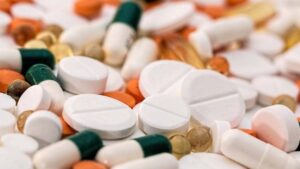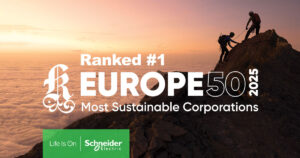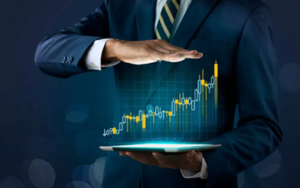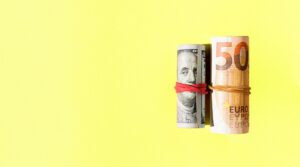
In January-May 2025, Ukraine imported medicines in dosage forms or packaged for retail trade for a total of $836.281 million.
According to the State Customs Service, exports of medicines during this period amounted to $92.989 million in monetary terms.
In addition, in the first five months of 2025, Ukraine imported non-dosed and non-packaged medicines for retail trade for $4.99 million, and ketgut, reagents, contrast agents, contraceptives and dental materials for $27 million.
The main countries from which Ukraine imports medicines are Germany (19.7%), India (10.4%) and France (7.36%). The main export markets are Uzbekistan (19.94%), Lithuania (19.7%) and Kazakhstan (13.4%).

Schneider Electric, a leader in digital transformation in energy management and automation, has been recognized as the most sustainable corporation in Europe by Corporate Knights, a Canadian media and research company specializing in corporate sustainability performance.
This recognition puts Schneider Electric at the top of the inaugural Europe 50 ranking, which evaluated more than 600 publicly traded European companies against a comprehensive set of sustainability criteria. This follows the company’s previous recognition in January 2025 as the world’s most sustainable corporation, which was also awarded by Corporate Knights as part of their renowned Global 100 ranking.
Together, these honors confirm Schneider Electric’s unwavering commitment to sustainability and its leadership in driving meaningful change across industries and geographies.
“At Schneider Electric, sustainability is not just a priority, it is embedded in our purpose and mission,” said Esther Finidori, Schneider Electric’s newly appointed Chief Sustainability Officer. “Being recognized as the most sustainable corporation in Europe is a strong endorsement of our efforts to make a positive impact through innovation, transparency and collaboration. We are proud to lead by example and remain committed to accelerating our contribution to a more sustainable and inclusive world.”
The Europe 50 is based on the same rigorous methodology as the Global 100, evaluating companies across a wide range of ESG (environmental, social and governance) performance indicators, such as carbon performance, net income, board diversity and sustainability-related investments. The scope of this ranking covers the constituents of the STOXX Europe 600 index, as well as the 100 largest public companies headquartered in Europe by market capitalization.
This dual recognition – both globally and regionally – underscores the positive impact that Schneider Electric is making. Through its innovative technologies and solutions, the company supports customers and partners in reducing their environmental footprint, improving energy efficiency, and advancing their sustainability goals.
About Schneider Electric
Schneider’s purpose is to create impact by empowering everyone to make the most of our energy and resources, ensuring progress and sustainability for all. We call it Life Is On.
Our mission is to be a trusted partner in sustainability and efficiency.
We are a global technology leader, bringing world-class expertise in electrification, automation and digitalization to smart industries, reliable infrastructure, future-proof data centers, smart buildings and intuitive homes. Drawing on our deep industry expertise, we provide integrated end-to-end AI-enabled industrial IoT solutions with connected products, automation, software and services, creating digital twins to drive profitable growth for our customers.
Our main resource is our 150,000 employees and more than a million partners operating in more than 100 countries to ensure proximity to our customers and stakeholders. We support diversity and inclusion in everything we do, guided by our meaningful purpose of a sustainable future for all.
www.se.c om
Discover the latest perspectives shaping sustainability, electricity 4.0 and the next generation of automation at Schneider Electric Insights.

The Decree of the President of the Republic of Uzbekistan “On additional measures to stimulate the attraction of foreign direct private investment” has been adopted.
The document is aimed at further improving the investment climate, supporting privatization processes, modernizing production facilities, and creating new jobs, especially in regions with excessive labor force.
According to the Decree, enterprises established with the involvement of foreign direct investment and operating in priority industries are entitled to tax incentives for a period of
The benefits apply to all cities and rural settlements of the republic, except for Tashkent city and Tashkent region. At the same time, these restrictions do not apply to companies operating in the tourism and waste management sectors.
Particular attention is paid to the industries to which these incentives apply. The list includes, in particular
production of radio electronics and components, light and silk industry, manufacture of construction materials, food and meat and dairy industries, chemical and medical industries, machine building, tourism, and waste management.

Issue #2 – June 2025
The purpose of this review is to provide an analysis of the current situation on the Ukrainian currency market and a forecast of the hryvnia exchange rate against key currencies based on the latest data. We analyze current conditions, market dynamics, key influencing factors, and likely scenarios.
Analysis of the current situation on the Ukrainian currency market
Ukraine’s foreign exchange market is entering the second half of the year amid relative stability in the domestic market and growing turbulence in the external market.
The current dynamics of the foreign exchange market is shaped by both external and internal factors that have the potential to change the exchange rate trajectory in the near future. The main topics of late June were the global weakness of the dollar, the emergence of new areas of tension on the global map, and the domestic agenda included the activation of the cash market in Ukraine and cautious currency liberalization, which continues under the control of the NBU.
Global context
Global markets are showing a strengthening of the euro amid a weakening dollar. The DXY index has reached its lowest level since 2022 – the US currency has lost more than 10% since the beginning of the year, and this drop could be the largest since the 1970s. The main trigger is political uncertainty in the United States. Rumors about Donald Trump’s intentions to replace the Fed chairman ahead of schedule and interfere with the institution’s activities have raised doubts about the independence of US monetary policy. Against this backdrop, the euro strengthened to USD 1.173, its highest level in three years, while the franc and yen also gained ground.
Although the Fed has so far refrained from changing rates, market expectations have already shifted and, accordingly, are being incorporated by market operators into exchange rate modeling and forecasting – the consensus expectation of international analysts regarding the likelihood of a rate cut at the next meeting has reached 25%.
At the same time, the ECB’s rhetoric remains cautious: the eurozone does not have enough institutional stability to challenge the dollar as the world’s reserve currency. The euro is growing mainly technically, due to the weakening of the dollar, rather than due to fundamental advantages, and strengthening its position is unfavorable for the European Union itself as an additional factor of pressure on exports.
Domestic Ukrainian context
The situation on the Ukrainian market is somewhat different. The cash segment is showing a sharp increase in demand: in May, banks brought $778 million of cash into Ukraine, which is 38% more than in April. In particular, the dollar amounted to $457 million (+52%) and the euro to $318 million (+22%). This indicates an increase in retail purchases, presumably by households that are either trying to lock in current exchange rate levels or increase savings in foreign currency amid seasonal growth in income and remittances, as well as increased devaluation expectations.
The charts show a widening of the spread between the euro buying and selling rates, which accompanies the growth of cash in the market. This signal is an indicator of nervousness in exchange offices and uncertainty about further exchange rate movements. The selling rate reacted more sensitively to the NBU’s exchange rate hike, while the buying rate grew more smoothly, indicating an imbalance in the supply/demand structure.
The National Bank of Ukraine maintains an active stance. Currency liberalization continues, but in a targeted manner, based on the principle of “new money – new conditions.” The NBU is not ready to completely lift restrictions and publicly recognizes that the risks of currency outflows are too high, which could upset the market balance.
The NBU’s readiness to ease restrictions or announcements of such actions could be a clear indicator that the ruling economic bloc has a fundamental vision of how to ensure a long-term balance in the domestic FX market, given the confirmation of further assistance from partners.
The government will soon declare its expectations for the average annual dollar exchange rate as part of the 2026 budget process.
Thus, the domestic FX market is entering a phase of searching for a new balance between controlled stability and growing external and internal risks.
US dollar exchange rate: dynamics and analysis
In June, the USD/UAH exchange rate remained generally stable with a moderate upward trend at the end of the month. Over the course of 30 days, the average purchase rate in banks increased from UAH 41.20 to UAH 41.42 per dollar, and the sale rate from UAH 41.70 to UAH 41.95 per dollar. The official NBU exchange rate rose from 41.52 to 41.69 UAH/$ over the same period.
In the shorter term, over the last week, the market showed stabilization after peaking in mid-June: the buying rate decreased from UAH 41.60-41.40/$, the selling rate was at UAH 42.15-41.95/$, and the official rate remained in the range of UAH 41.83-41.64/$. Thus, there were no sharp fluctuations and the exchange rate dynamics remained controlled.
The dynamics of spreads between buying, selling, and the official exchange rate shows that banks do not expect significant changes in the market and do not include additional premiums or risks in the exchange rate. This indicates a balance of demand for the dollar, stability in market behavior, and the absence of panic or speculative sentiment.
Key influencing factors:
Forecast:
Euro exchange rate: dynamics and analysis
In June, the euro demonstrated steady growth with minimal deviations, strengthening its position amid a weakening US dollar on global markets and continued strong demand for the euro in Ukraine. Over the past 30 days, there has been a gradual but steady increase in all key benchmarks: the average bid rate rose from ~46.80 to ~48.60 UAH/€, the ask rate from ~47.50 to almost 49.40 UAH/€, and the official NBU rate from ~46.90 to 48.48 UAH/€. The last week of June showed a certain acceleration of these dynamics.
These changes indicate a strong upward trend in the euro amid a weakening dollar, speculative interest, and a gradual recovery in import activity.
Key influencing factors:
Forecast:
In general, the euro market in Ukraine is showing a trend of active growth amid both global factors and domestic demand. The single currency is currently showing significantly higher volatility and market dynamics than the dollar.
Recommendations for businesses and investors
July will bring controlled stability to the dollar and strong growth to the euro. All of this is against the backdrop of a global tug-of-war between the dollar and the euro. In such an environment, the currency strategy should remain flexible, adaptable and designed for several different scenarios.
Liquidity is paramount. All foreign currency assets should be held in instruments with the ability to respond quickly. Time deposits, bonds without the possibility of early withdrawal, or pegging to one currency are potential traps. In the coming months, the focus should not be on yield, but on maintaining the ability to maneuver quickly.
Euro – growth has gained market momentum. After a significant rise in June, the market is still in the phase of appetite for the euro, and although some of the news has already been taken into account, volatility remains. If you need to reformat the share of this currency in your portfolio, it is best to do so gradually, when spreads narrow or pressure from global drivers decreases.
The dollar is still an important element of protection. The current stability does not mean that the dollar has lost its functions and appeal. On the contrary, it is worth keeping in your portfolio in the medium to long term: a devaluation trend for the hryvnia is likely in the fall or winter, which will reward patient dollar holders with strong nerves.
Spreads are the main marker for decisions. While spreads remain stable on the USD/UAH pair, they are widening again on the EUR/UAH pair. This indicates the return of nervousness and uncertainty: when operators put additional margin into the rate, it is a signal to take your time. When the spread is narrowing, it is time to analyze entry.
Fixed “currency benchmarks” are forbidden. The exchange rate predictability of recent weeks is not a basis for patterned actions or excessive optimism. Continue to work with 3-4 exchange rate scenarios and test how your asset structure will work in each of them.
Hryvnia – do not hold more than you need. It is still stable, but external imbalances are growing. Excessive accumulation of hryvnia funds creates risks. The hryvnia mass in excess of the operating reserve should be transferred to any of the reliable currencies or instruments linked to them.
Currency liberalization is more of a signal than an instruction to act. The NBU’s signals about easing restrictions are important, but so far they are more of a symbolic step. The real effect will be seen closer to the fall. Investors and businesses should not only follow the liberalization steps, but also keep in mind the possibility of the regulator’s reverse actions if the exchange rate scenario forces it to return to restrictions. You may want to consider investing in currency instruments that are least dependent on government actions, such as cash or stablecoins based on reliable currencies.
Keep your focus on the euro. If your business model involves expenses or revenues in euros, you should review the structure of currency risk, build a safety margin into contracts or test possible scenarios for a breakout above 50 UAH/€.
What is important in the news. First of all, the publication of indicators and exchange rate targets of the government and the NBU for 2026 as part of the budget process.
This material was prepared by the company’s analysts and reflects their expert, analytical professional judgment. The information provided in this review is for informational purposes only and should not be construed as a recommendation for action.
The Company and its analysts make no representations and assume no liability for any consequences arising from the use of this information. All information is provided “as is” without any additional guarantees of completeness, obligations of timeliness or updates or additions.
Users of this material should make their own risk assessments and informed decisions based on their own evaluation and analysis of the situation from various available sources that they consider to be sufficiently qualified. We recommend that you consult an independent financial advisor before making any investment decisions.
REFERENCE
KYT Group is an international multi-service product FinTech company that has been successfully operating in the non-banking financial services market for 16 years. One of the company’s flagship activities is currency exchange. KYT Group is one of the largest operators in this segment of the Ukrainian financial market, is among the largest taxpayers, and is one of the industry leaders in terms of asset growth and equity.
More than 90 branches in 16 major cities of Ukraine are located in convenient locations for customers and have modern equipment for the convenience, security and confidentiality of each transaction.
The company’s activities comply with the regulatory requirements of the NBU. KYT Group adheres to EU standards, having a branch in Poland and planning cross-border expansion to European countries.

Please find below the current tenders of PJSC Ukrnafta announced in June 2025:
Overhaul of the oil collector “GZU-+++-GZU-+++” +++ of the Centralized Oil and Gas Processing Division “Okhtyrka Petroleum Gas” of PJSC Ukrnafta in Okhtyrka district, Sumy region.
Expected value of the procurement: UAH 11.00 million excluding VAT
Deadline for submission of bids: July 14, 2025.
Details are available at the link.
***
CNC turning center.
Expected value of the procurement: UAH 9.98 million excluding VAT
Deadline for submission of bids: July 04, 2025.
Details at the link.
***
Weighted drill pipes without threads in assortment.
Expected purchase price: UAH 11.70 million excluding VAT
Deadline for submission of bids: July 09, 2025.
Details at the link.
***
We invite reliable partners to cooperate!
“Ukrnaftais the largest oil company in Ukraine and the operator of the national network of filling stations. In March 2024, the company took over the management of Glusco’s assets and operates 545 filling stations – 461 owned and 84 managed.
The company is implementing a comprehensive program to restore operations and update the format of its filling stations. Since February 2023, the company has been issuing its own fuel coupons and NAFTAKarta cards, which are sold to legal entities and individuals through Ukrnafta-Postach LLC.
Ukrnafta’s largest shareholder is Naftogaz of Ukraine with a 50%+1 share.
In November 2022, the Supreme Commander-in-Chief of the Armed Forces of Ukraine decided to transfer to the state a share of corporate rights of the company owned by private owners, which is currently managed by the Ministry of Defense.

UKRNAFTA has been ranked in the TOP-5 of the Institute of Consumer Expertise. Its experts checked compliance with state standards of diesel fuel at Ukrainian gas stations. As a result, diesel from UKRNAFTA turned out to be one of the highest quality on the market.
Sergiy Fedorenko, Commercial Director of UKRNAFTA, emphasizes that the company carefully monitors the supply of only high-quality fuel to the network.
“Before the diesel gets into our customer’s tank, it undergoes several laboratory tests: when the railcar or tanker arrives, when it is transferred to the fuel truck, and then directly at the filling station network. This is done by our laboratories as well as independent laboratories so that we can control the quality from several sides. This fully complies with DSTU and European standards,” he said in a commentary to the Yedynye Novosti TV marathon.
The TV spot reminds us that high-quality fuel is one of the main prerequisites for reliable and durable operation of your car. Because even one refueling, for example, with low-quality diesel, can lead to problems with the fuel system and engine. As a result, the car may face expensive repairs.
That’s why car owners choose only trusted gas station chains. And they, in turn, pay special attention to fuel quality control at their filling stations.
“So, of course, you need to look at the brand and the reputation of the filling station to be sure that there will be quality fuel. We carry gasoline from Poland and Germany, and diesel fuel from a huge number of supplier countries. Tankers from Canada, Sweden, Israel, and Greece bring diesel to various ports where we can import it,” added Sergiy Fedorenko.
“Ukrnafta is Ukraine’s largest oil producer and operator of a national network of filling stations. In March 2024, the company took over the management of Glusco’s assets and operates a total of 545 filling stations – 461 owned and 84 managed.
The company is implementing a comprehensive program to restore operations and update the format of its filling stations. Since February 2023, the company has been issuing its own fuel coupons and NAFTAKarta cards, which are sold to legal entities and individuals through Ukrnafta-Postach LLC.
Ukrnafta’s largest shareholder is Naftogaz of Ukraine with a 50%+1 share.
In November 2022, the Supreme Commander-in-Chief of the Armed Forces of Ukraine decided to transfer to the state a share of corporate rights of the company owned by private owners, which is now managed by the Ministry of Defense.